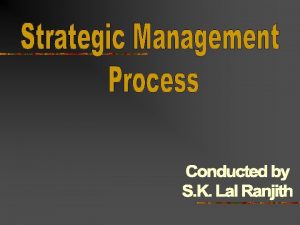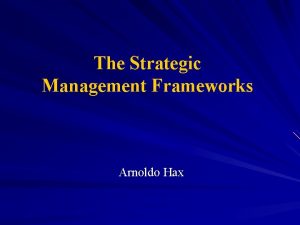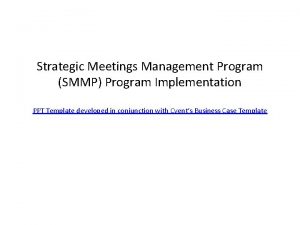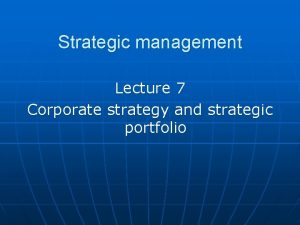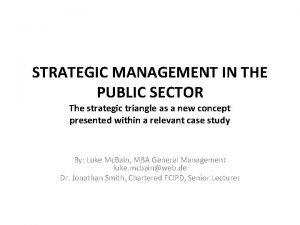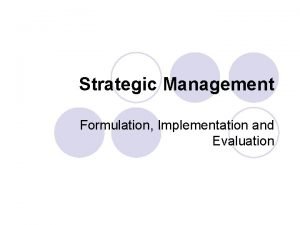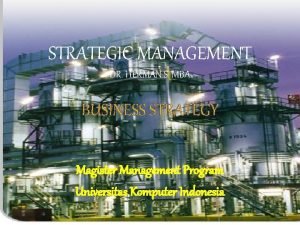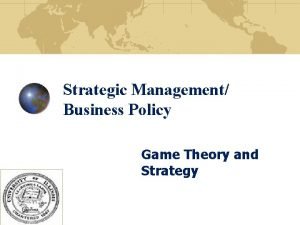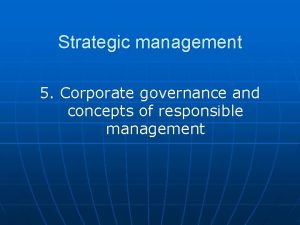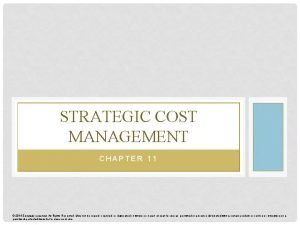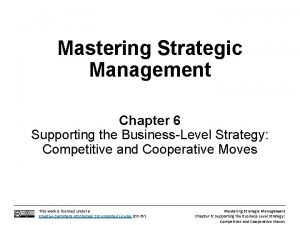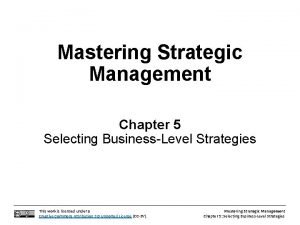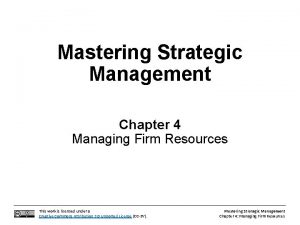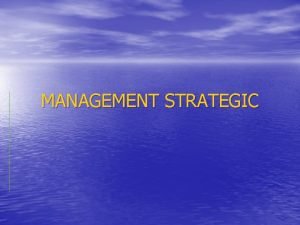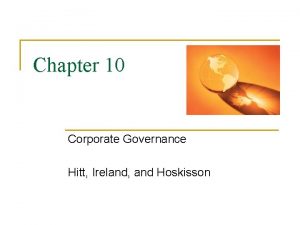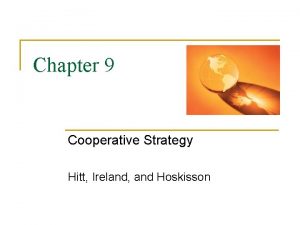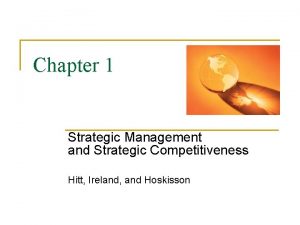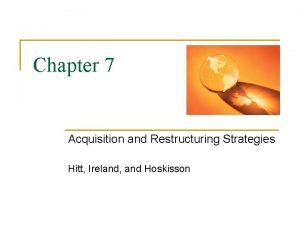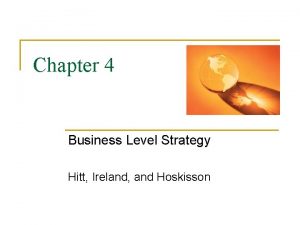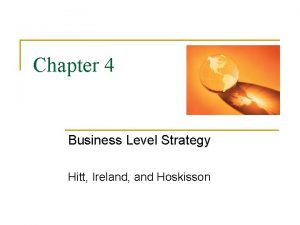1 Strategic Management Hitt Ireland Hoskisson 2007 7
































- Slides: 32

1 Strategic Management Hitt, Ireland Hoskisson, 2007 7 e Edition Daniel Degravel

2 Ch. 1 Strategic Management and Competitiveness Definitions … Strategy Strategic Competitiveness Competitive Advantage Average Return AR Above Average Return AAR Risk Strategic Management Process Strategic Flexibility Organizational Slack Strategic Intent Strategic Mission Challenges of Strategic Management Hyper Competition Technology Globalization -Rate of Change -Information -Knowledge Intensity Two basic Strategic Approaches Stakholders (three groups) Corporate Culture Strategic Leaders (Who are they, What’s their work, Prediction of outcomes) I/O Model RB Model Necessity of Strategy?

3 Ch. 2 External Environment: O, T Competition and Competitor Analysis Definitions Box General Environment Industry Environment Competitor Analysis Opportunity Threat Industry Market micro structure General Environment PEST Model Political P 5 F Model New Entrants Products Substitution Barriers to Entry BTE Economies of Scale Eo. Sca Switching Costs Technology Economic Industry Environment P 5 F Model Strategic Mapping (Strategic Groups) Competitor Analysis Socio. Cultural Strategic Group Competitor Analysis Competitor Intelligence Demographic Global Segment

4 Ch. 2 External Environment: O, T Competition and Competitor Analysis (Ctd. ) General Environment NE BPS Industry Environment P 5 F Model S BPC R PS Competitor Analysis Strategic Mapping (Strategic Groups) + Firms - +

5 Ch. 3 Internal Environment: Resources and Competences Definition Box… Firm = Bunch of resources Resources Environments: MIGHT DO vs. CAN DO Finance Physical assets Technology Value Chain Outsourcing Advantages Disadvantages Concept of Value-Chain ies Primary Rigid it Resource Competence or Capability HR Organization Reputation Patents Network Decisions concerning R&C: -Uncertainty -Complexity -Intra-Org. Conflict Support Competence C = R+A+R Core Competitive Advantage Strategic Competitiveness Intangible Tangible Resource Value Creation Competences (Core) Characteristics Valuable Rare Costly-toimitate Costly-to-imitate Non Substituable Strategic Competitiveness Competitive Advantage … Choice of Business Strategy IFE L ITED LIM Core Competence + Position in Px. M = Competitive Advantage

6 BL Strategy = integrated and coordinated set of commitments and actions the firm uses to gain a competitive advantage by exploiting core competencies in specific businesses p. 105 Deliberate choie about how firm will perform the value chain activities in ways that create unique value p. 111 Ch. 4 Business-level Strategies Customer = key 3 Attributes Reach Richness Affiliation Clients are the foundation Returns earned from relationships with customers is lifeblood of organizations 3 dimensions Who? What? How? Market segmentation p. 108 FMS p. 127 Information networks (CRM, ERP) p. 129 TQM p. 130 CL Strategy: Which businesses in portfolio? BL Strategy: How do you compete in each business? Creation of value for stakeholders Purposeful Linked with Mission and Intent Alignment R&C with environment Five generic BL strategies M. Porter Analysis of COST and DIFF with the valuechain COST DIFF Integrated C-D Focused COST Focused DIFF Analysis of the five generic strategies for each of the five forces of P 5 F model BPS, BPC, NE, PS and R Perform different or differently Superior fit among activities of the value-chain

7 Ch. 5 Competitive Dynamics and Rivalry Definition Box… Competitive - Rivalry - Behavior - Dynamics Strategic behavior Success Anticipation Action Competitive Dynamism (All firms) Multimarket Competition Slow-cycle market Standard-cycle market Fast-cycle market Market Commonality Resource Similarity Dependence on the market First Mover Second Mover Late Mover Competitive - Action - Response Strategic Tactical Reputation Slow-Fast markets MC MS Model of competitive Rivalry (Competitors) Movers -Quality Rivalry -Size Drivers Likelihood of attack A, M, A, D Perceived Gain/Loss Likelihood of response Type of competitive action Reputation Dependence

8 Ch. 6 Corporate-level Strategies Corporate-level strategy = actions taken to gain a competitive advantage by selecting and managing a group of different businesses competing in different industries, the portfolio of businesses Objective: Earn AAR Degree to which the businesses are worth more under the management of the firm than they would be under any other (separate) ownership(s) DIV has best effect if interaction of resources, motives and incentives DIV appropriate for the R&C and O&T Model of Related Diversification and performance p 193 Fundamental Option: Increase or Decrease Portfolio by engaging in new businesses or exiting businesses you are presently running Diversification DIV Concentration CON

9 Ch. 6 Corporate-level Strategies Reasons for Diversification Operational relatedness (sharing activities) Reduction of top management employment risk Economies of Corporate relatedness (transferring Scope competences) RDIV Size and complexity increase compensation III Value. Reducing Diversification I Value-creating Diversification Anti trust regulation Tax law Low performance Uncertain future cash flow Risk reduction for firms Tangible resources Intangible resources II Value-Neutral Diversification Market Power RDIV Multipoint Competition (blocking competitors) Vertical Integration Efficient internal capital Financial allocation (asymmetry of Economies access to information) Business Restructuring

10 Ch. 6 Corporate-level Strategies Portfolio Strategy The big Picture ct e r i D a r t S l iona No Change Stability STOP Development Diversification DIV Sell out/Divestment Old Bankruptcy Turnaround (contraction/expansion) Market Internal growth External growth Partnerships … GO Retrenchment Concentration CON No strategic change Improvement of operational efficiency Deployment Strategy Corporate Strategy Vertical Integration Horizontal Integration Internationalization … New Product Old New Diversification Marketing Product DIVMP Diversification Strategic Marketing Market Diversification DIVMM DIV Expansion

11 Ch. 7 Acquisition and Restructuration Strategies Popular means of development Several waves of Acquisition and Mergers Merger = Integration of operations on a relatively co-equal basis Acquisition = a firm controls 100% interests in another firm Take over = special type of acquisition in herein the target firm does not solicit the acquiring firm’s bid. Many are referred as hostile Reasons for Acquisition Restructuring Problems Acquisition Ways of dealing with problems

12 Ch. 7 Acquisition and Restructuration Strategies (Ctd. ) REASONS FOR ACQUISITION 1 - Market power Horizontal, Vertical and related Acquisition Reasons for Acquisition 2 - Overcoming BTE 3 - Cost of Product development and speed to market 4 - Increased diversification 5 - Reshaping firm competitive scope 6 - Learning and developing capacities Restructuring = 1 - Downsizing 2 - Downscoping 3 - Leveraged Buyouts

13 Ch. 7 Acquisition and Restructuration Strategies (Ctd. ) Problems Ways of dealing with problems POTENTIAL PROBLEMS… TO ENHANCE SUCCESS… Lots of failures or very incomplete achievements 1 - Integration phase 2 - Inadequate evolution of target 3 - Debt 4 - Instability to achieve synergy Synergy Transaction cost 5 - Over-diversification 6 - Over-focus of managers on acquisition 7 - Too large acquisition 1 - Complementary assets 2 - Groomed before (test) 3 - Friendly acquisition 4 - Effective dire diligence process 5 - Financial slack 6 - Innovation 7 - Flexibility 8 - Adaptability 9 - experience of managers 10 - Effective integration

14 Ch. 8 Internationalization Strategies Contents of chapter 8 1 - Why do you Internationalize? 6 - How hard is it? Complexity of managing multinational firms Opportunities 2 - What type of International strategy do you choose? 5 - What are consequences for you in terms of competitiveness? Strategic competitiveness outcomes International strategies 3 - What does the environment “tell” you? Environmental trends 4 - How do you make it practically? Choice of international entry mode

15 Ch. 8 Internationalization Strategies (Ctd. ) CLASSIC RATIONALE FOR INTERNATIONAL DIVERSIFICATION 1 - Product life-cycle 2 - Secure needed resources 3 - More universal product demand globalization 4 - Eo. Sca 5 - Pressure for cost reduction 6 - Size of potential market 7 - Currency fluctuations, decreasing risk of devaluation 8 - Need for local operations 9 - Laws and regulations 1 - Why do you Internationalize? FOUR BASIC BENEFITS 1 - Increased market size 2 - Return On Investment Recoup more rapidly R&D and development expenses 3 - Eo. Sca, Eo. Sco and learning 4 - Location advantages

16 Ch. 8 Internationalization Strategies (Ctd. ) 5 - What are consequences for you in terms of competitiveness? BASIC OUTCOMES 1 - INT DIV increases Returns 2 - INT DIV increases Innovation 2 - What type of International strategy do you choose? International strategies INTERNATIONAL STRATEGIES 1 - Business level strategies Porter’s Diamond of competitiveness (factors of production) 2 - Corporate level strategies -Multi-domestic (several independent countries) -Transnational (global integration) -Global (Both multi-domestic and Transnational)

17 Ch. 8 Internationalization Strategies (Ctd. ) 3 - What does the environment “tell” you? Environmental trends 6 - How hard is it? ENVIRONMENTAL TRENDS Liability of foreigners Regionalization Triad Complexity of managing multinational firms RISKS and LIMITS Political Risk Economic Risk Organizational limit Economic limit

18 Ch. 8 Internationalization Strategies (Ctd. ) Degree of Involvement New wholly owned subsidiary Entry Modes + 4 - How do you make it practically? Acquisitions Choice of international entry mode Strategic Alliances Licensing 0 - Dynamics of mode of entry - Mode best suited to situation - Sequentially or back-and-forth or skip entry modes Exporting 0 Time +

19 Ch. 8 Internationalization Strategies (Ctd. ) Another typology of international mode of entry 1 - Exportation Direct and indirect exportation 2 - Foreign Direct Investment FDI Commercial, administrative, production or research subsidiaries 3 - Contractual arrangements License sale or leasing Franchise Sale of technology “Turn-key” contracts and engineering and international consultancy

18 Ch. 9 Cooperative Strategies Cooperative strategy = organizations working together to achieve a shared objective Collusive strategy = organizations cooperating to raise prices above the fully competitive level Strategic alliance = cooperative strategy in which organizations combine some of their resources and capabilities to create a competitive advantage Strategic Alliances Joint Venture Equity strategic alliance Non-Equity strategic alliance Why? Because you create value together that you could not create alone -Slow-cycle market -Standard-cycle market -Fast-cycle market

19 Ch. 9 Cooperative Strategies (Ctd. ) B-L Cooperative Strategies Complementary Strategic alliance -Share R&C -Vertical -Horizontal Competitive Strategy -Strategic response -Response to attack Reducing uncertainty Strategy Hedge against risk and uncertainty Reducing Competition Strategy -Explicit collusion -Tacit collusion -Mutual forbearance

20 Ch. 9 Cooperative Strategies (Ctd. ) C-L Cooperative Strategies To grow through means different than M&A Fewer resources needed Greater flexibility Testing process for future potential M&A Diversifying Strategic alliance -DIV or CON on core businesses Synergetic Franchising Strategic International alliance Corporate Eo. Sca strategy Cross-border Strategic alliance Network Cooperative strategy -Multiple partnerships -Stable alliance network -Dynamic alliance network

21 Ch. 9 Cooperative Strategies (Ctd. ) Risks Managing Cooperative strategies 1 - Partner acts opportunistically 2 - Organization has misrepresented R&C it can bring 3 - Organization will not make it available for its partners 4 - Organization makes a specific investment to the alliance and the partner does not Cost Opportunity minimization maximization management Importance of Trust Effectively managed, cooperative strategy can be rich and effective

22 Ch. 10 Corporate Governance = relationhip between stakeholders used to dsetermine and control the strategic direction and performance of the Organization Four roles of Corporate Governance Ensure that strategic decisions are made effectively Establish order between parties Reflects and reinforce Values Corporate Governance sometimes fails but wellfunctioning CG can create a competitive advantage Oversight when stakeholders may have a conflict of interest

23 Ch. 10 Corporate Governance (Ctd. ) Four CG mechanisms (3 internal, 1 external) Ownership Concentration Board of Directors Executive Compensation Market for Corporate Control Corporate Governance in International contexts Examples of Germany and Japan Corporate Governance and Ethics At least the minimal interests of Stakeholders should be met Organization is very much vulnerable to its agents’ unethical behavior

24 Ch. 10 Corporate Governance (Ctd. ) Ownership Concentration Separation Ownership and management Board of Directors Agency relationship Board of Directors Insider Outsider Related Outsider Diversification as a problem Enhancing effectiveness of Board: Agency costs Managerial opportunism Ownership concentration Institutional owners SHo activism 1 - Diversity 2 - Internal management and accounting control systems 3 - Formal process to evaluate Board’s performance 4 - “Lead” Director 5 - Compensation of Directors (Decrease stock options) Three characteristics for Directors

25 Ch. 10 Corporate Governance (Ctd. ) Executive Compensation Market for Corporate Control Executive Compensation Align Organization and top managers’ interests Complicated CG mechanism because difficult to link managers’ Action and Performance Variations in compensation (direct vs. indirect, short term vs long term) Market for corporate control Loss of job? Managerial defense tactics Mf. CC may not be totally efficient

26 Ch. 11 Organizational Structure and Controls Structure = formal reporting relationships, procedures, controls and authority and decision-making processes: « how to do the job » . Structure is the Framework within which strategies are designed and implemented Necessary Fit « Strategy-Structure » Strategy Structure CONTROL STABILITY vs FLEXIBILITY Change of Strategy implies often Change of Structure But Organizational Inertia Actual – Expected ACtual – Reference Point (Industry) Strategic Control Financial Control

27 Ch. 11 Organizational Structure and Controls (Ctd. ) So in response: Structure and Strategy evolve: -Volume -Geography -Vertical Integration -Diversification Simple Functional Divisional Three main Dimensions: Structure Formalization Centralization Departmentalization

28 Ch. 11 Organizational Structure and Controls (Ctd. ) Structure Strategies

29 Ch. 11 Organizational Structure and Controls (Ctd. ) CORPORATE LEVEL BUSINESS LEVEL F COST DIFF INTEG D Cooperative DIV Related Constrained D SBU Form DIV Related Linked D Competitive DIV Unrelated INTERNATIONAL INT Geographic Area INT Product COOPERATIVE INT Multidomestic INT Global Divisional INT Combination INT Transnational N N Alliance Cooperative Alliance (Vertical Horizontal) N Franchise N International Strategic Network

30 Ch. 12 Strategic Leadership Models … Key Strategic Leadership Actions Model #1 SIY p. 375 Leadership and the SMP Role of Leaders in the process Directions Model #2 EOM p. 377 Determinants of Managerial Discretion Which variables influence managers’ decisions / actions? Issue: Managers as a key organizational Resource Culture Magt Ethics and CSR Resources Portfolio Magt Control of the Organization Issue: Top Management teams and role of stakeholders (Corporate Governance)
 Carrie cullen hitt
Carrie cullen hitt Kom hitt
Kom hitt Industrial organization model of above average returns
Industrial organization model of above average returns Strategy analysis and choice largely involves making
Strategy analysis and choice largely involves making Strategic fit vs strategic intent
Strategic fit vs strategic intent Puppy dog ploy
Puppy dog ploy Pyramid levels of management
Pyramid levels of management Management pyramid
Management pyramid Top management middle management first line management
Top management middle management first line management Five tasks of strategic management
Five tasks of strategic management Arnoldo hax
Arnoldo hax Strategy executing process
Strategy executing process Balanced scorecard meaning
Balanced scorecard meaning Types of functional strategy
Types of functional strategy Strategic meeting management programs
Strategic meeting management programs What is corporate strategy in strategic management
What is corporate strategy in strategic management Political management in strategic triangle
Political management in strategic triangle Formality in strategic management
Formality in strategic management Sfas analysis example
Sfas analysis example Strategic management lecture
Strategic management lecture Business policy game
Business policy game Corporate governance chain
Corporate governance chain Characteristics of strategic management
Characteristics of strategic management Process of strategic cost management
Process of strategic cost management Social responsibility and ethics in strategic management
Social responsibility and ethics in strategic management Steepv model
Steepv model Strategic management nature and scope
Strategic management nature and scope Competitive profile matrix of mcdonalds
Competitive profile matrix of mcdonalds Strategic management chapter 6
Strategic management chapter 6 Strategic management chapter 5
Strategic management chapter 5 Strategic management chapter 4
Strategic management chapter 4 Analiza concurentilor
Analiza concurentilor A retailer must develop
A retailer must develop









